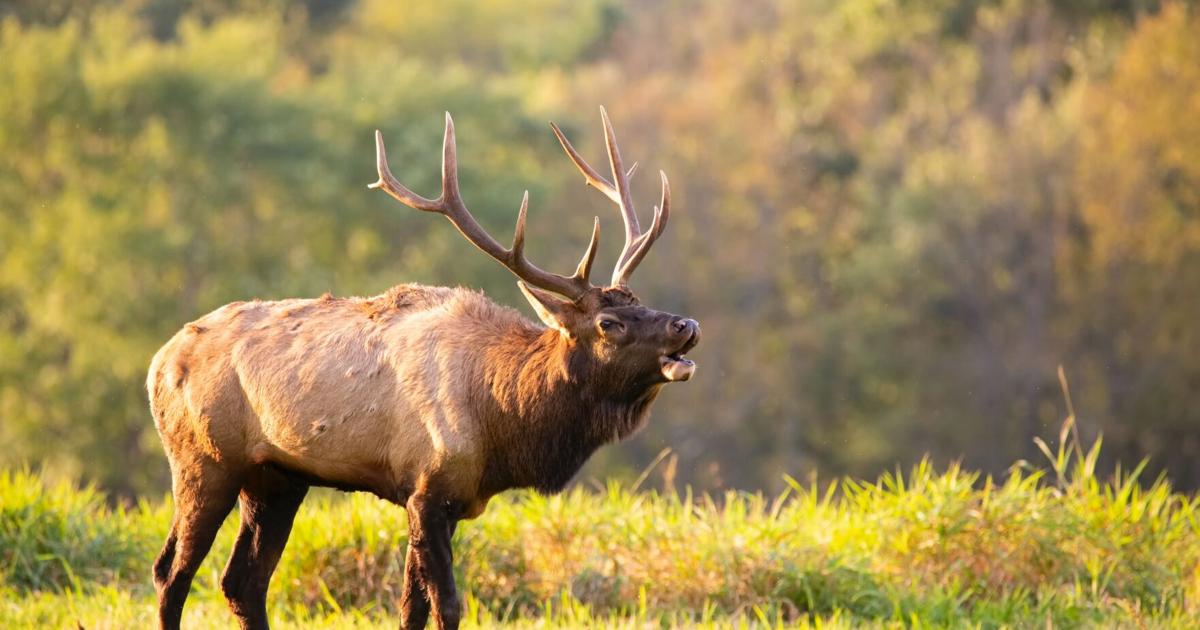Northern Arizona’s storied relationship with elk

In Arizona, wildlife flourishes, and around the beginning of September, everything is elk. They announce their season with a blast of their bugle — an edgy, high-pitched scream that sounds downright eerie in a hollow.
That trademark bugle is not the only distinctive feature about elk. They have a surprising connection to some seafaring and jungle mammals, and they sometime like to chuckle.
Like every member of the deer family, bull elk like to hang with other males while the cows band together with the calves. When mating season starts, bulls starting as young as two years use their bugle to find a mate.
The bugle starts low, gradually climbs to a high note, hangs onto the high note and then drops back to the low note with a gruff at the end. That high note, as distinctive as it is curious, doesn’t match the 700-pound-plus source because it doesn’t come from the bull’s vocal cords.
People are also reading…
Scientists discovered the high note is more of a whistle produced in an area called the glottis, situated between the bull’s vocal cords in the throat and then projected through the nasal cavities. The call can measure as high as 4,000 Hz and carry for miles.
Sometimes the bull adds a series of sharp guttural sounds called a chuckle. The bull also uses a special glunking sound to communicate with cows. The call, produced deep in the bull’s throat, sounds like a squishy thump.
Cow calls are short and naggy with an occasional long and strong screech. A calf call is tiny and light, like the mew of a cat.
The bugling can start as early as late August from bulls 4 years and older; younger elk start in September. If you catch sight of an August bugler, he will probably have an impressive rack.
“A lot of people talk about elk horns,” said Allen Zufelt, Arizona Game & Fish Region 2 Terrestrial Game Specialist. “They’re not horns, they’re antlers, and they’re shed every year. They will continue to increase in size until they’re 6 to 8 years old. After that they’ll decrease in size.”
Both genders of elk have two canine teeth. They’re remnants of tusks, like walruses, elephants and wild boars have, that their prehistoric ancestors once had.
“They’re ivory teeth,” Zufelt said. “The same residual kind of canine located in their upper jaws.”
The elk that currently roam the state are Cervuc canadensis or Rocky Mountain elk. But Arizona once had a native elk population whose existence didn’t trickle into scientific circles until 1882 when renowned naturalist E.W. Nelson started tracking the clan. By the time Nelson penned a report on the elk for the American Museum of Natural History in 1902, the species had been extirpated.
Nelson called Arizona Elk, which he referred to as Cervus merriami, as “the last of the large game mammals to become known to science in America.” The species stayed under the radar because of their isolated existence in an area where, Nelson wrote, “the idea of game protection is very recent.”
At the time, the elk in the U.S. had been dwindling from an estimated 10 million and would eventually reach a low of 90,000; that’s almost half of the remaining elk lived in and around Yellowstone National Park. The park ended up transplanting more than 13,500 Rocky Mountain elk, to points around the nation from 1912-1967. During that time, 217 came to Arizona.
When the transplantations started, George Hunt was governor of Arizona and a member of the Elks U.S.A. Globe lodge. He and Winslow lodge member C.M. Bledsoe coordinated Arizona’s first shipment that traveled by train on January 31, 1913 to Winslow, Arizona. The elk were then wheeled by wagon to a draw in the Chevelon Canyon system. Two shipments of transplants to other locations in Arizona occurred in the 1920s.
The Arizona Game & Fish Department (AGF) estimates Arizona currently has about 35,000 elk that are all descendants of the Yellowstone transplants, and they sure have gotten around.
“Elk in general are very nomadic,” Zufelt explained. “We have elk that moved to all habitats, from the tops of the San Francisco Peaks to as far as some of the canals around Yuma. They’re originally a plains animal, and they are very good at living in almost any habitat. Once they get to a place, they’re pretty good at persisting.”
That would describe the elk that wandered up to the Grand Canyon National Park from Williams and Flagstaff sometime around 1966. About 95% of the park elk remain in and around Grand Canyon Village; a 2015 survey counted 200. Though they must mingle with millions of visitors, they hydrate from precipitation that collects on the ground, puddles that form at water stations and quick nips of nectar from hummingbird feeders; they find food in the form of forb, grass and visitor handouts; and they have no predators. Life, in other words, is good.
If you’re interested in spotting elk, you don’t have to travel far to find them. AGF game specialists have been flying elk surveys in the area, and Zufelt reported they spotted 3,000 in the past week.
“One of the best places a person has to more or less guarantee seeing elk this time of the year is Mormon Lake,” Zufelt said. “The elk make use of the lake bottom in the summertime. They’ll be breaking up in the next couple of weeks as hunting season starts and they’ll be breeding. So they’ll move around a little bit. But there were 150-200 elk out in the lake bottom just the other day.”
If you go to Mormorn Lake, be careful. Elk accidents have decreased substantially along the freeways due to customized fencing. But the smaller roads, like Lake Mary Road, still have frequent elk crossings.
“The best thing I can say is slow down when you’re driving at night,” Zufelt advised. “Drive courteously and pay attention, so you’re not distracted because it just takes a split second for an elk to step out in front of you.”
Be the first to know
Get local news delivered to your inbox!





